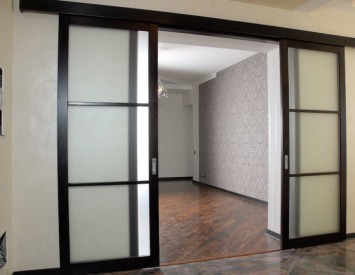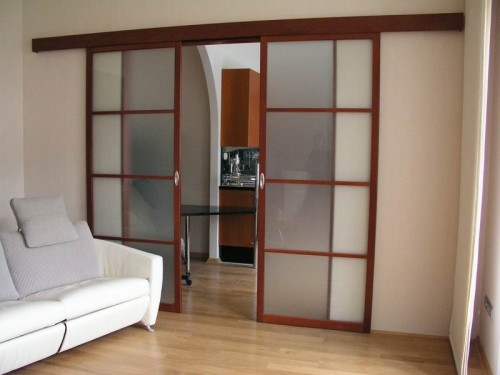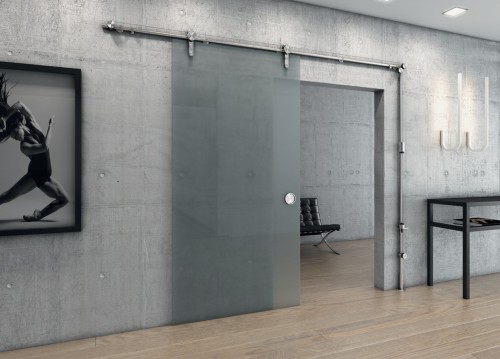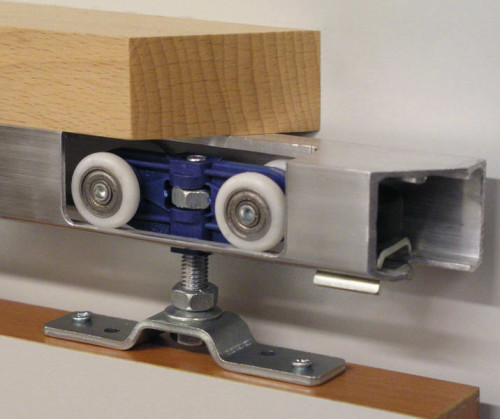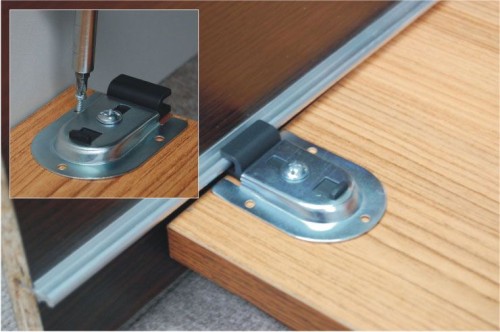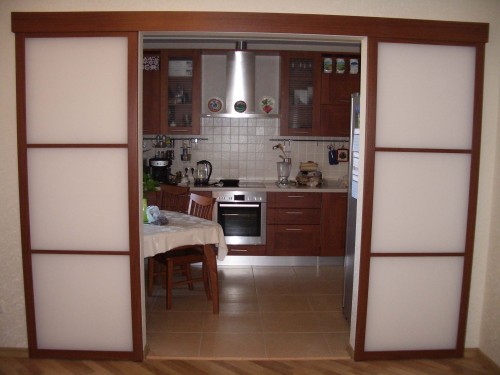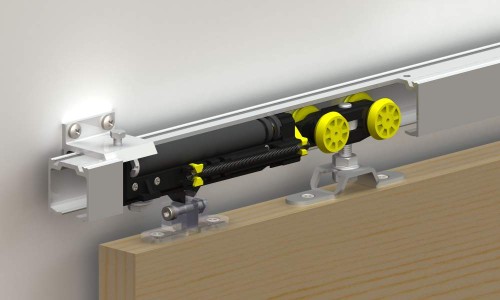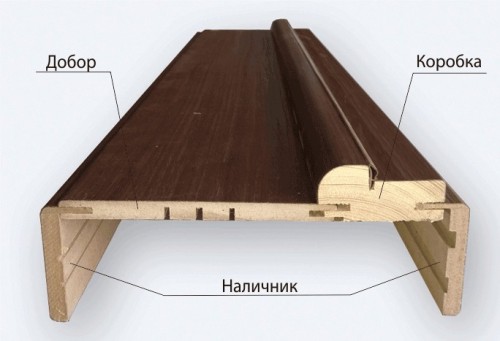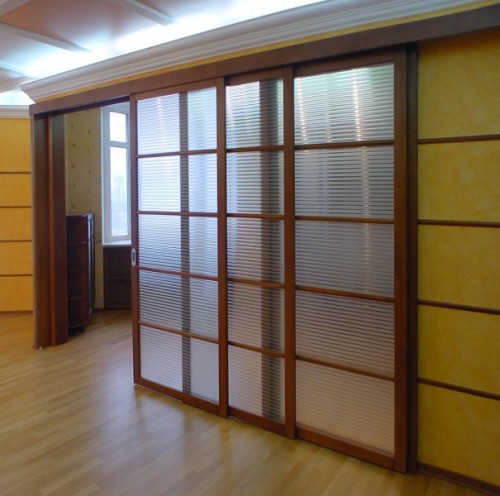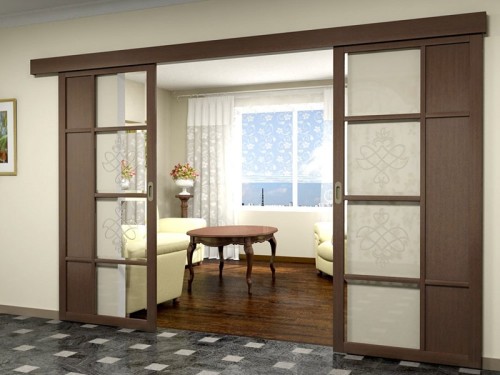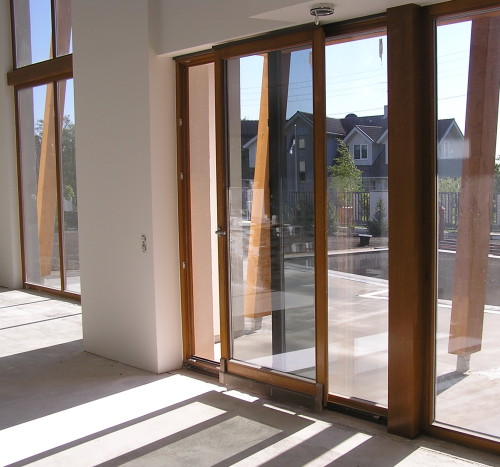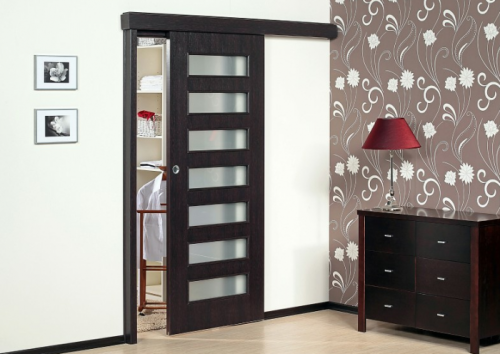Sliding doors are an ideal solution for small rooms. Such designs do not conceal the space, in addition, they look very original and non -standard. In this article, we will talk about the features and types of such doors, and also tell you how to install a sliding door with your own hands.
Content
Types of sliding doors
Such designs can be classified according to various signs. For example, depending on the design features, sliding interior doors are divided into:
- cascading structures;
- radius doors;
- harmoses doors;
- single, double -leaf, tricaries.
Doors can also be made of different materials, the most popular are wooden and glass structures. This factor is important if the system is supposed to be installed with your own hands. For example, for the installation of the simplest wooden door, you will need a guide with one gutter, as well as two carriages with rollers. In the case of installing a glass door, you will have to stock up on a large number of materials, namely, prepare a lot of roller mechanisms, since heavy glass exerts significant pressure on the entire structure.
Glasses with poor fixation risk falling and crashing, so it is recommended to mount them using two rails: upper and lower. This installation method will ensure good door stability. The sliding mechanisms themselves in this case are fixed between two plates, laid from the inside with special rubber lining.
There are two types of sliding doors:
- The hidden intra -ostatic mechanism provides for the functioning of the structure in which it is hidden in the wall. It is possible to mount such a door only at the stage of the construction of the wall, since in its thickness it is necessary to provide a gap in which the sash will be hidden. It should be borne in mind that the thickness of the wall will increase, and this will reduce the free space in the room. But the door itself will subsequently save a lot more space than the usual hollow structure.
- Doors with an open mechanism can be mounted not only at the stage of wall construction, but also at any convenient time. In the presence of such a mechanism, the sash will move along the wall, but for this it is necessary to provide free space from the side in which the door will open.
The external sliding mechanism allows you to use a lot of door movement options, so you can choose the most convenient way. To close a very wide doorway, it is recommended to use systems with four sash, where the internal canvases will open towards the external ones.
Before installing a sliding door, you should familiarize yourself with their classification by type of fixation. Three types of structures are distinguished depending on this characteristic:
- Doors that are fixed on the upper suspension.
- Structures that are fixed on the lower suspension. With this method of fixation below, a small threshold is obtained, which is acceptable for cabinets and dressing rooms, but inconvenient for interior doors. Porogs can be drowned in the floor, but this will require additional time and labor. But the installation of systems on the lower suspension is the fastest and easiest process.
- Doors that are recorded in two mentioned methods. This type of installation is considered the most reliable and durable.
Advantages and disadvantages of sliding doors
Before installing sliding interior doors, it does not hurt to get acquainted with the pros and cons of such structures. First, we’ll deal with the advantages:
- the plus of sliding doors is their originality and non -standard, an attractive and unusual appearance;
- saving space is another advantage of such systems. Furniture or other interior items cannot be placed behind the usual swing door, while in the presence of a sliding structure, the entire area of \u200b\u200bthe room can be used really;
- the safety of such doors is also considered an indisputable advantage, because it is simply impossible to hit a hard angle in the dark;
- sliding doors do not open from the draft.
Such designs are not devoid of disadvantages, among which the following can be distinguished:
- a complex and labor -cost method of installation;
- if the door is not mounted independently, you will have to spend money on paying for the work of the masters;
- low sound and heat-insulating properties can also be classified as disadvantages;
- if the system has a hidden intra -ostatic mechanism, it is quite problematic to take care of it. If you need to clean the space in the thickness of the wall, it is enough just to spill it with a convenient nozzle, but for small repair of the structure, part of the wall will have to be dismantled;
- over time, some videos may become unusable and require replacement.
Installation of a sliding door
Regardless of the mechanism of action and fastening, all sliding doors consist of the same type of elements. These include guides, roller mechanisms, as well as the door leafs themselves. In addition, various decorative details, fixers, dobages, as well as a variety of fittings in the form of locks and handles are used. Work on installing a sliding system can be described step by step.
Step 1: Installation of guide profiles
The first step in the wall is marked in those places where the structure will subsequently be installed. Focusing on this marking, guides for sliding doors are fixed on the surface. If the system will have the lower suspensions, they can be cut into the floor to get rid of the rock. In this case, in the thickness of the flooring, you will have to make a gap, but you can provide everything in advance and even before the floor decoration, fix the guides on the concrete screed.
Important: in the process of installing profiles, it is necessary to check their horizontalness using the construction level.
The next stage is the installation of the upper guide profile. This profile should be fixed strictly above the lower, and you can check its position using the control line. The height of the upper profile installation should be equal to the height of the door itself and take into account a small increase of 1.5-2 cm. This increase is needed to provide gaps between the door leaf and the surfaces of the ceiling and floor. Keep in mind that the guides should be mounted strictly horizontally so that the structure stands evenly and does not spontaneously shift.
As for the length of the guide profile, this indicator should be equal to the double width of the canvas and take into account an increase of 5 cm for the normal course of the door. If the system is provided in the system, you need to leave the supply for him.
When installing a conventional wooden structure, the profiles can be fixed with brackets, but if we are talking about a heavy glass or a massive board, it is better to additionally strengthen the system using a wooden beam. At first, such a beam is mounted on the wall, and later the guide profile is fixed on it.
If the wall in the house is laid out with brick or consists of monolithic concrete, then dowels should be used as fasteners. In the case of a plasterboard wall, in its frame it is necessary to equip an additional profile in advance, and the installation of the guide should be carried out directly on it. In the work, it is recommended to use an anchor for drywall.
Step 2: fixation of holders and accessories
The next stage in the installation of sliding doors is the strengthening of brackets on the canvas, which will hold the door on roller carriage. Such brackets are mounted according to the instructions and are located on the sides of the upper end. The optimal type of holders for all types of sliding systems, with the exception of the design-harmonica, are considered clamps that are attached on the sides of the door. In the case of a glass sheet, metal mounts with rubber gaskets are used, between which the glass is fixed. Such clamps relieve the need to drill holes for fasteners in the glass door.
When installing the farm door, special brackets with a rotary roller are put on each section.
In the process of installing the door holders, you can also be equipped with handles and locks, if they need. Then, when the sliding system takes its place and will be adjusted, it will be possible to install the locking mechanism of the lock. Please note that when installing hidden systems, pens and other fittings should be deepened into the thickness of the door leaf.
Step 3: Hanging door
The next step in the installation of a sliding door with your own hands is the direct installation of the door wards. It is better to do such work together. One person will hold the door while the second turns the carriage into the grooves of guide profiles. If the door acts as an interior partition and the profiles are mounted from wall to wall, the rollers for the sliding door are pre -introduced into the groove through a specially provided window. After that, the holders at the end of the canvas are joined with an anchor extending from the carriage.
Step 4: Installation of closers and limiters
So that the carriage with the rollers does not fall out of the grooves of guide profiles, you need to put limiters. As such limiters, special plugs are used in the form of the profile, as well as studs, which are installed in the guide in the indicated places.
Tip: So that the door does not make loud sounds when opening, choose limiters with rubber stops. Such details will also not allow the movable elements of the system to deteriorate too quickly.
Step 5: Installation of inhibits and platbands
The platbands on a sliding door are mounted in order to protect the mechanism from dust and various contaminants. Another function of such details is decorative. The platbands are used to give a neat type to systems with an open mechanism, for intra -stest doors they are not needed.
The platbands are mounted on the wall using brackets, but you can fix them on the guiding profile with special latches.
Step 6: adjusting the mounted structure
The last stage of installation of the sliding door is to check the result of the work and adjust the system. If at the initial stage of the door installation guide profiles were fixed strictly horizontally, the canvas should stay evenly and do not shift anywhere on its own. In this case, the adjustment process will not take much time. It will be enough to check whether the door is tightly adjacent to the restrictive structure, whether the canvas moves parallel to the floor, whether there are unnecessary gaps in the places of contact of the door with the wall. At the very end of the work, you also need to check whether the sash on the guides move easily and freely, whether the fittings work properly, whether all the details are well fixed.
Sliding doors, photo:
